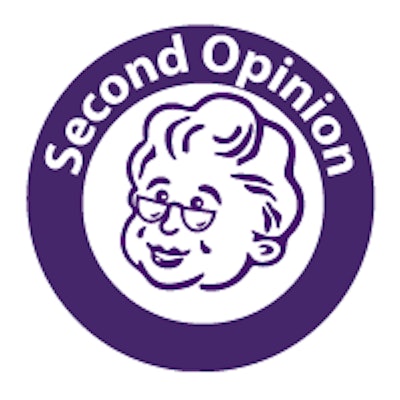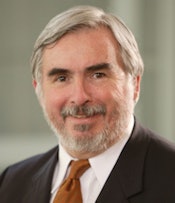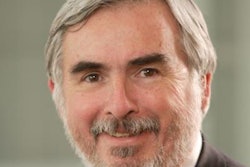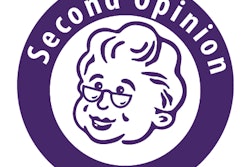
"The large print giveth, but the small print taketh away." That quote by musician Tom Waits could well be applied to this week's decision by the U.S. Centers for Medicare and Medicaid Services (CMS) approving Medicare payment for CT lung cancer screening. The move has rightly been applauded as a titanic victory for public health, with the potential to save the lives of many thousands of people harmed by tobacco carcinogens. This is indeed cause for jubilation.
Celebration of the decision must, however, be tempered with the realization that there are a number of poison pills in the ruling that will leave many of those at very high risk of lung cancer without insurance coverage, and inevitably result in thousands of unnecessary deaths.
 Thoracic surgeon Dr. Frederic W. Grannis Jr.
Thoracic surgeon Dr. Frederic W. Grannis Jr.In an earlier comment to AuntMinnie.com readers, I described how a small cadre of individuals on the Medicare Evidence Development and Coverage Advisory Committee (MEDCAC) with conflicts of interest related to payors hijacked the CMS advisory panel process by recommending that CT screening be limited by a number of contingencies. All of these contingencies have been institutionalized in the CMS decision. The result is that a large number of individuals at very high risk of lung cancer will be denied coverage.
Most obvious is the failure to provide coverage for individuals with a prior cancer caused by tobacco products. Let's take as examples three lung cancer survivors five years after completion of treatment, one 54 years old, one 76 years old, and one 65 years old, who either had exposure of only 29 pack-years or who quit smoking 16 years earlier.
Each has an enormous risk of lung cancer, i.e., 20% over a decade. The number of people needed to screen to find a lung cancer in such a high-risk cohort is five, and the number needed to get a cure over five years is six or seven -- well within established guidelines for the cost-effectiveness of screening. Yet these individuals would not be eligible for reimbursement under the new CMS guidelines.
The largest research study supporting screening in such individuals is from Memorial Sloan Kettering Cancer Center and lists Dr. Peter Bach as a co-author, yet Bach did not describe his own research results in his testimony to the MEDCAC panel. This illogical exclusion puts tens of thousands of survivors at risk.
Seniors 75 and older are also left in harm's way. Although such individuals are at higher risk than those below age 74 -- lung cancer risk increases strongly with advancing age -- they are denied coverage under the CMS decision. This is an issue that must be addressed and protested by AARP and other senior's groups immediately. Seniors with private insurance will have coverage, while seniors with federal insurance are excluded -- a major inequity.
Chronic obstructive pulmonary disease (COPD) and bullous emphysema also dramatically increase the risk of lung cancer, but individuals with these conditions are also excluded from screening if they do not otherwise qualify under the proposed guidelines.
No good deed goes unpunished
The next group excluded under the new CMS criteria falls under the category of "no good deed goes unpunished." Individuals who have behaved responsibly and quit smoking are rewarded by exclusion from insurance coverage. What effect will this disparity have on national smoking cessation policies?
Also excluded are individuals, both younger and older, who have additional exposures to known carcinogens, including but not limited to radiation, asbestos, chromate and arsenic, radon, secondhand smoke, and air pollutants. A recent publication from the Lahey Clinic documents that such individuals (those who meet criteria established in National Comprehensive Cancer Network lung cancer screening guidelines) would experience benefits from CT screening equal to those meeting CMS inclusion criteria.
There are also a number of innocent-appearing rules in the CMS statement that will markedly restrict the number of individuals who will benefit from CT screening. Let's start with the reasonable-sounding requirement that screening centers meet quality regulations. This regulation would have the salutary effect of preventing repetition of low-quality screening encountered early in the mammography experience. The agency's rigorous criteria, however, will have the undesirable side effect of delaying and limiting the number of centers available to screen millions at risk.
The mandate that all participating centers must enter data from all patients screened will provide valuable data for future screening research, but because there is no reasonable prospect of federal funding for such data collection, and because many good community screening centers may not have the information technology and personnel resources to meet this requirement, fewer centers will be available to save lives by screening patients at risk.
There is a further trapdoor in the requirement for data registry. Such data registration is intended to and will pressure centers not to exercise common sense and compassion in screening high-risk patients who do not meet strict eligibility criteria. For example, consider the following hypothetical dialogue: "Sorry, but even though you have an enormous risk of lung cancer because you are a survivor who has 60 pack-years of exposure and worked in a shipyard for 20 years, we cannot screen you because you quit smoking 16 years ago. If we screen you, we may lose our center-of-excellence designation."
Insidious mandate
Perhaps the most insidious mandate is that there must be a "shared decision-making" session between the patient and his or her primary physician before screening may proceed. Although this sounds perfectly reasonable and innocent, as I emphasized in my prior comment, wise selection and interpretation of accurate data is critical to such a process.
The main question here is regarding which decision-making tools are used. Some tools being promoted as meeting this requirement contain marked underestimates of survival and marked overestimates of harms. If a patient is provided with such falsely low estimates of potential survival benefits and inaccurately high estimates of risks of screening, it can be confidently anticipated that he or she will probably opt against being screened.
For example, if a high-risk patient is informed that his chance of cure would be 21% if a cancer is detected, that a high percentage of lesions treated would be nonlethal, and that there is a reasonably high risk of him getting cancer from diagnostic radiation, what decision might one reasonably anticipate the patient would make?
The cumulative result of all of these provisions in the CMS decision will be a marked reduction in the number of people at risk who will be screened -- and correspondingly lower spending by CMS and private insurers. Is this an incidental side effect of good policy, or a cynical ruse on the part of payors? You decide.
What now?
Where do we go next? The best option would be for CMS to correct its mistakes when it publishes its final decision. I am not sanguine in believing this will happen, but professional and advocacy groups must urge CMS to make the system equitable, responsible, and compassionate. One absolute necessity is public comment from senior groups such as AARP, whose constituents will be those most ill-served by their government.
In a worst-case scenario in which the final CMS decision is unchanged, a number of things need to happen.
First, the process of certification of screening centers of excellence must be facilitated and accelerated. If the government mandates creation of a national screening database, it must provide grant funding, expertise, and support for its maintenance. Centers with requisite radiographic expertise for whom database participation would be a hardship or an impossibility should be granted exemptions. Meaningful data for research does not require that all screening centers participate.
We must also move forward immediately with funding for research to investigate the benefits and risks of lung cancer screening in younger and older individuals, nonsmokers involuntarily exposed to secondhand smoke and air pollution, those with heavy radon exposure or prior radiation therapy, and other groups with a potential increased risk of lung cancer.
Finally, we must fund research to try and solve the very difficult problem of early detection of lung cancer in nonsmokers, women in particular.
We must also seek additional funding for screening in the form of continued litigation to compel tobacco companies to pay for medical monitoring of their present and former customers.
The comments and observations expressed herein are those of the author and do not necessarily reflect the opinions of AuntMinnie.com.




















